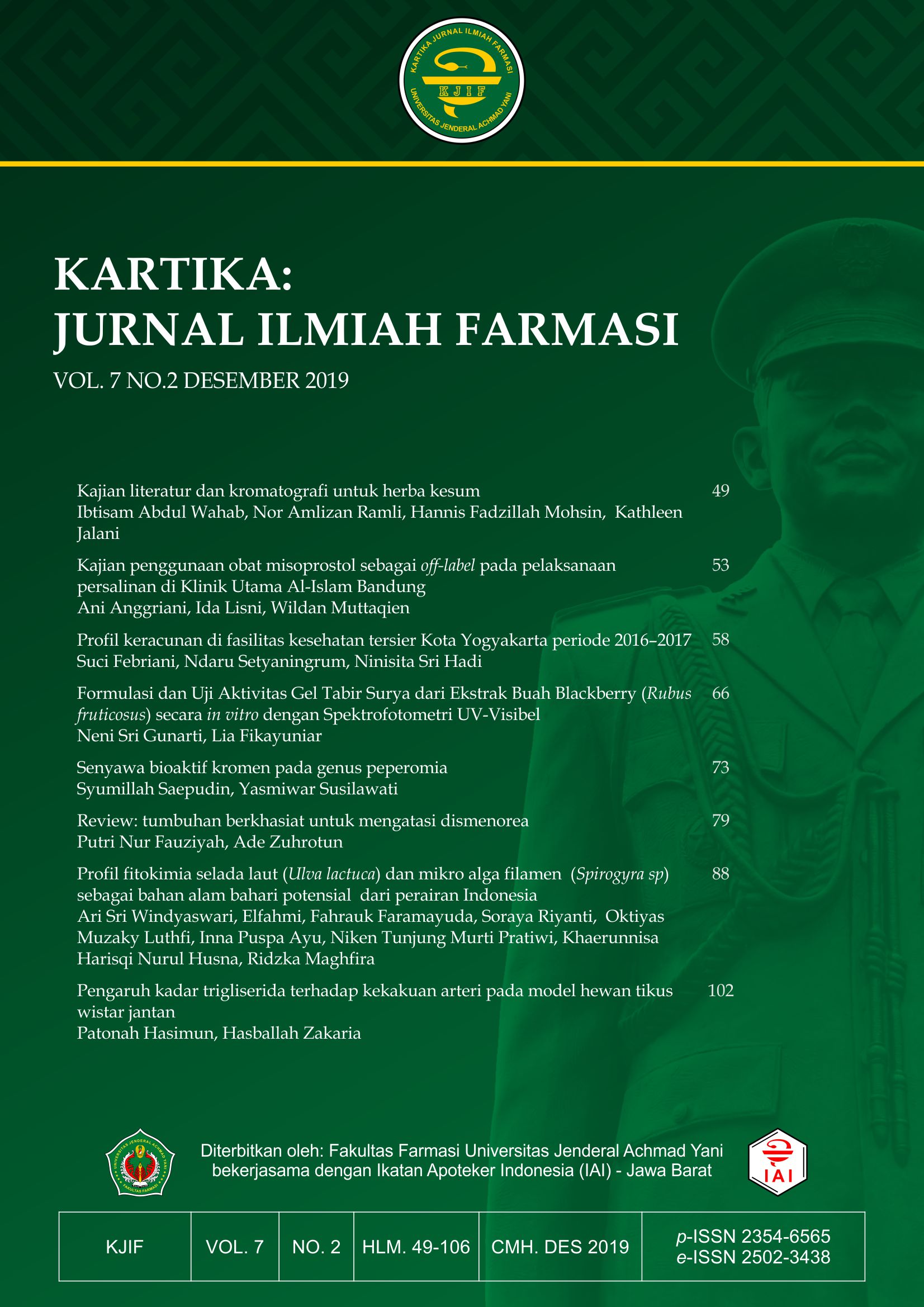KAJIAN LITERATUR DAN KROMATOGRAFI UNTUK HERBA KESUM
DOI:
https://doi.org/10.26874/kjif.v7i2.308Abstrak
ABSTRAK
Â
Spesis Polygonum (misalnya P. aviculare) dilaporkan mempunyai kandungan alkaloid. Begitu juga dengan daun kesum (P. minus Huds), yang terbukti sebagai sumber molekul perubatan semulajadi. Masalah yang diidentifikasi dari kajian kesum termasuklah di dalam aspek fitokimia genus Polygonum ini, yang belum pernah disiasat secara mendalam. Oleh itu, sasaran kajian ini adalah untuk mengulas data biokimia tumbuhan tersebut melalui metode literatur serta menjalankan telaah analisis kimia terhadap ekstrak kesum. Dari artikel dan jurnal penerbitan, bahagian daun dan akar dipelajari melalui kaedah kromatografi kolom. Tambahan itu, sebatian kimia dari kesum dicirikan dengan teknik spektroskopi resonans magnetik nuklear. Temuan signifikan diperolehi apabila senyawa indol dan alkaloid diterpen C20 berjaya dikarakterisasi. Secara kesimpulannya, projek di masa hadapan boleh ditumpu kepada ujikaji antikanser dan anti-penuaan dari herba kesum ini. Â
Â
Kata kunci : herba, kesum, literatur, Polygonum
Â
ABSTRACT
Â
Polygonum species (e.g. P. aviculare) were reported to consist of alkaloidal nature. Likewise, the kesum leaves (P. minus Huds) is proven as a source of natural medicinal compound.  The identified problem in the kesum research would include the phytochemistry aspects of this Polygonum genus, which is not yet thoroughly investigated, via literature search.  Therefore, the aim of this study is to accumulate and review the biochemical data of this herb. From the articles and published journals, the leaves and root extracts were analysed by using liquid chromatographic technique. In addition, the chemical substance from kesum could be elucidated via nuclear magnetic resonance spectroscopy. The significant findings could be obtained when the indole and and C20-diterpene alkaloids were successfully characterised. In summary, future directions of the project could focus on anticancer and anti-aging experiments of this kesum herb.
Â
Keywords    : herb, kesum, literature, Polygonum
Referensi
Baharum, S. N., Bunawan, H., Abd. Ghani, M., Wan Mustapha, W. A., and Mohd Noor, N. (2010): Analysis of the Chemical Composition of the Essential Oil of Polygonum minus Huds. Using Two-Dimensional Gas Chromatography-Time-of-Flight Mass Spectrometry (GC-TOF MS). Molecules, vol. 15(10), 7006-7015.
Biotropics Malaysia Berhad, (2019): Laman diakses pada Agustus 2019 melalui https://www.biotropicsmalaysia.com.
Christapher, P. V., Parasuraman, S., Christina, J. M., Asmawi, M., dan Vikneswaran, M. (2015): Review on Polygonum minus. Huds, a commonly used food additive in Southeast Asia. Phcog Res., vol. 7, 1-6.
George, A., Chinnappan, S., Chintamaneni, M., Vandana Kotak, C., Choudhary, Y., Kueper, T., dan Radhakrishnan, A. K. (2014): Anti-inflammatory effects of Polygonum minus (Huds) extract (Lineminusâ„¢) in in-vitro enzyme assays and carrageenan induced paw edema. BMC Complementary and Alternative Medicine, vol. 14, 355 - 361.
Globinmed (Global Information Hub On Integrated Medicine), (2018): Laman diakses pada Agustus 2019 melalui http://www.globinmed.com.
Mahmood, A., Mahbub, N., Hossain, S., Raisa, Z., dan Dash, P. R. (2019): Phytochemistry and Pharmacological Importance of Polygonum Viscosum: A Review, Int. J. of Pharmacognosy, Vol. 6(1), 1-5.
Mohd Ghazali, M. A., Al-Naqeb, G., Selvarajan, K. K., Hasan, M. H. dan Adam, A. (2014): Apoptosis Induction by Polygonum minus Is Related to Antioxidant Capacity, Alterations in Expression of Apoptotic-Related Genes, and S-Phase Cell Cycle Arrest in HepG2 Cell Line, BioMed Research International, vol. 2014, Article ID 539607, 13 pages, 2014. https://doi.org/10.1155/2014/539607
Pramita, D., Harlia, dan Sayekti, E. (2013): Karakterisasi Senyawa Alkaloid Dari Fraksi Etil Asetat Daun Kesum (Polygonum minus Huds). Jurnal Kimia Khatulistiwa, vol. 2(3), 142-147.
Shahar, S., Aziz, A. F., Ismail, S. N., Yahya, H. M., Din, N. C., Manaf, Z. A., dan Badrasawi, M. M. (2015): The effect of Polygonum minus extract on cognitive and psychosocial parameters according to mood status among middle-aged women: a randomized, double-blind, placebo-controlled study. Clin Interv Aging, vol. 10, 1505–1520.
Urones, J. G., Marcos, I. S., Pérez, B. G., dan Barcala, P. B. (1990): Flavonoids from Polygonum minus. Phytochemistry, vol. 29, 3687-3689.
Qader, S. W., Abdulla, M. A., Lee, S. C., and Hamdan, S. (2012): Potential bioactive property of Polygonum minus Huds (kesum) review. Scientific Research and Essays, vol. 7(2), 90-93.
Vikram, P., Chiruvella, K. K., Abdullah Ripain, I. H., dan Arifullah, M. (2014): A recent review on phytochemical constituents and medicinal properties of kesum (Polygonum minus Huds.), Asian Pacific J. of Tropical Biomedicine, vol. 4(6), 430-435.
Wiart, C. (2006): Medicinal Plants of Asia and the Pacific, 1st Edition, CRC Press, 47-51.
##submission.downloads##
Diterbitkan
Cara Mengutip
Terbitan
Bagian
Lisensi
Penulis yang menerbitkan artikel pada jurnal ini menyetujui ketentuan berikut:
- Penulis memberikan hak cipta dan jaminan atas artikel sebagai publikasi pertama, yang memberikan kesempatan pada orang lain untuk membagi artikel dibawah lisensi Creative Commons Attribution License
- Penulis dapat melakukan perubahan dan menambahkan untuk pendistribusian artikel yang terpublikasi secara non eksklusif (misalnya, mempostingnya ke repositori institusional atau mempublikasikannya dalam sebuah buku), dengan pengakuan publikasi awal dalam jurnal ini.
- Penulis diizinkan dan didorong untuk memposting pekerjaan mereka secara online (misalnya, di repositori institusional atau di situs web mereka) sebelum dan selama proses pengajuan, karena dapat mengarah pada pertukaran produktif, serta kutipan pekerjaan sebelumnya dan lebih besar yang diterbitkan (Lihat The Effect of Open Access).























